 |
| And then the sun lit the world |
We started for Panna National Park at 4ish in the morning in a Safari jeep shared with another couple, booked by the hotel we were staying at in Khajuraho. It was late November and pretty foggy. I wasn't carrying a jacket and the chill had almost gotten under my skin; almost to my bones ( idiom aside I meant it literally) but the anticipation of getting lucky this time to sight a tiger after several failed attempts before, kept the cold at bay.
We arrived at the park within an hour. It was still dark when we passed through a dense deciduous stretch of Sal, tendu, acacia, bamboo, arjuna, and other trees I don't know the names of. The only wild creature I noticed was big yellow Nephila, the Golden silk orb weaver spiders (I think that's the species), resting in the center of their giant intricate arty webs. For once I felt even creepy arachnoids can be beautiful. My antique camera couldn't capture a very clear photograph in the bad light from a moving jeep. That's the umpteenth time I reminded myself, that it's time to replace my good old buddy of 10 years (I seem to hold on to the silly misconception that even inanimate objects have feelings).
As the jeep drove deeper into the forest, we could hear the rustle of trees suggesting animal presence but none came close enough to be sighted. Am sure the animals are well aware of the safari trails now and keep a safe distance. Sigh :(
As if to complement the vermilion of the rising sun, the vegetation changed to a stretch of open dry grassland, a beautiful golden hue blanketing the earth. Impeccably camouflaged in that yellow lea were the first animals we saw, the golden spotted deer or chital as they are called in Hindi. Honestly, having seen deer so many times; even once, almost accidentally driven over one in Sioux Falls on my way to the badlands, I should have been more nonchalant but excitement surged in at the very sight of those elegant bucks, at least some animal on a tiger safari if not a tiger itself.
Moving on, the jeep re-entered a stretch of denser forest where we met some langurs and sambars but a tiger !!! nopes!! the guide said a tiger was sighted just the day before. Yes, that's what happens always, tigers are sighted the day before or the day after but not on the day. Someday perhaps!
 | |
| On the safari trail |
Parts of the Panna National Park originally belonged to the royal family of Panna. In 1981 it was taken over by the government for the conservation of the big striped cats. When counted in the early 2000s, the park had some 30-40 tigers but by 2009 the number shockingly dropped to zero. It was a huge blow for the Tiger conservationists and the park authorities. What caused such a catastrophe for the cats!? A report was published soon after thorough investigations of the shocking revelations, which suggested that some cats died a natural death after a 15-year life span, some were killed by the local villagers while protecting their livestock, some were poached by tiger smugglers, and some fell prey to revenge machinations of dacoits against local authorities. Additionally, the environmentalists blamed the diamond mines in operation in the region for endangering the tiger habitat. Ironically, most of the mines were shut down by 2009. The mining companies retaliated claiming the tigers died after the mines were shut down proving mines were not damaging the animal's habitat. The battle continued and all mines were ordered to shut down by 2016.
Meanwhile, the park authorities decided to bring tigers from Pench to help breed them again at Panna. It was a risky proposition since relocation often causes emotional damage to the relocated animal. There was the danger of losing the relocated animal as well. The risk however was taken and it successfully paid off amidst many challenges. There is a heart-wrenching story about a relocated male tiger, who was so homesick that he walked almost 200 miles, halfway back to Pench before getting tracked by the Park authorities. I wonder how helpless he must have felt on being brought back to a place he didn't belong to. Who knows what he was missing, who had he left behind in Pench, and why he wanted to go back. As animals, they cannot express their feelings and we take them for granted :( Well! eventually, the project of relocating the tigers worked for Panna, and currently, there are about 22 tigers in the park. A feat the park is mighty proud of :)
 |
| Back on the tiger trail |
Tiger conservation in India has definitely come a long way and successfully strode forward. Tigers habited 23 countries in the past but now they can be found in 11 countries only. Cambodia and Vietnam are the recent two countries to announce the extinction of this species from their forests. Laos, Thailand, Malaysia, Myanmar, Bangladesh, Russia, China, Nepal Bhutan, and Indonesia are the only remaining countries where tigers can still be found other than India which is the home of 70% of the world's wild tigers. These big cats need enough space food and protection from poachers to survive and multiply and this could be achieved in India because of extensive tiger conservation awareness projects, community participation, passionate conservationists, and forest officers and guards.
 |
| A well-spent afternoon by the Ken |
 | |
| Long-tailed Hanuman Langur are Old world monkeys native to the Indian subcontinent |
LOCATION:
State: Madhya Pradesh
Country: India
HOW TO REACH:
Panna National Park can be best reached from Khajuraho which has an airport and a railway station. The park is about an hour away from Khajuraho by car. One can hire a safari jeep from Khajuraho.
WHAT TO WEAR:
Light cotton is good since the weather is mostly warm. For winters a jacket is a must, especially if taking the early morning safari.
WHERE TO STAY:
The park has its own resort. Plus there are other resorts close by. Many stay in Khajuraho.
 |
| Sambar is a large deer native to South and South-East Asia. Currently, it is on the endangered list due to hunting and habitat loss. |




No comments:
Post a Comment
Please Share Your Thoughts :)